
James Augustine Aloysius Joyce was an Irish novelist, poet and literary critic. He contributed to the modernist avant-garde movement and is regarded as one of the most influential and important writers of the 20th century. Joyce's novel Ulysses (1922) is a landmark in which the episodes of Homer's Odyssey are paralleled in a variety of literary styles, particularly stream of consciousness. Other well-known works are the short-story collection Dubliners (1914), and the novels A Portrait of the Artist as a Young Man (1916) and Finnegans Wake (1939). His other writings include three books of poetry, a play, letters, and occasional journalism.
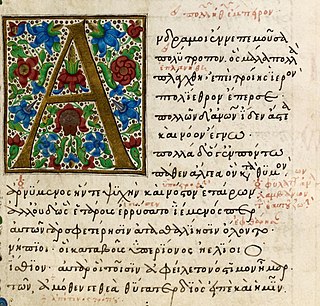
The Odyssey is one of two major ancient Greek epic poems attributed to Homer. It is one of the oldest extant works of literature still widely read by modern audiences. As with the Iliad, the poem is divided into 24 books. It follows the Greek hero Odysseus, king of Ithaca, and his journey home after the Trojan War. After the war, which lasted ten years, his journey lasted for ten additional years, during which time he encountered many perils and all his crew mates were killed. In his absence, Odysseus was assumed dead, and his wife Penelope and son Telemachus had to contend with a group of unruly suitors who were competing for Penelope's hand in marriage.
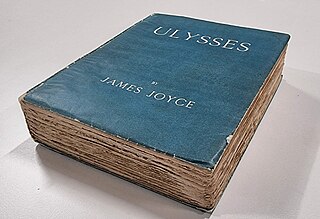
Ulysses is a modernist novel by Irish writer James Joyce. It was first serialized in parts in the American journal The Little Review from March 1918 to December 1920 and then published in its entirety in Paris by Sylvia Beach on 2 February 1922, Joyce's 40th birthday. It is considered one of the most important works of modernist literature and has been called "a demonstration and summation of the entire movement." According to Declan Kiberd, "Before Joyce, no writer of fiction had so foregrounded the process of thinking".

Molly Bloom is a fictional character in the 1922 novel Ulysses by James Joyce. The wife of main character Leopold Bloom, she roughly corresponds to Penelope in the Odyssey. The major difference between Molly and Penelope is that while Penelope is eternally faithful, Molly is not. Molly is having an affair with Hugh 'Blazes' Boylan. Molly, whose given name is Marion, was born in Gibraltar on 8 September 1870, the daughter of Major Tweedy, an Irish military officer, and Lunita Laredo, a Gibraltarian of Spanish descent. Molly and Leopold were married on 8 October 1888. She is the mother of Milly Bloom, who, at the age of 15, has left home to study photography. She is also the mother of Rudy Bloom, who died at the age of 11 days. In Dublin, Molly is an opera singer of some renown.
Roger Gilbert Lancelyn Green was a British biographer and children's writer. He was an Oxford academic who formed part of the Inklings literary discussion group along with C. S. Lewis and J. R. R. Tolkien. He had a positive influence on his friend, C.S. Lewis, by encouraging him to publish The Lion, the Witch and the Wardrobe.

The House of the Arrow is a 1924 mystery novel by the English novelist A. E. W. Mason, the third full-length novel featuring his recurring character Inspector Hanaud. It has inspired several films of the same title.

At the Villa Rose is a 1910 detective novel by the British writer A. E. W. Mason, the first to feature his character Inspector Hanaud. The story became Mason's most successful novel of his lifetime. It was adapted by him as a stage play in 1920, and was used as the basis for four film adaptions between 1920 and 1940.
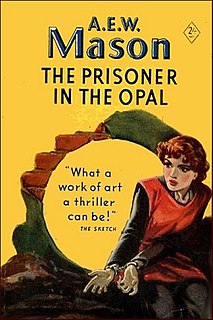
The Prisoner in the Opal is a British detective novel by A.E.W. Mason, serialised in The Pall Mall Magazine and published in book form in 1928. It is the third full-length novel in Mason's Inspector Hanaud series, and the only one to feature the occult as a significant plot point.
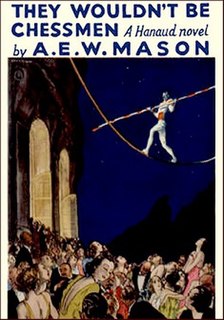
They Wouldn't Be Chessmen is a 1935 British detective novel by A.E.W. Mason. It is the fourth full-length novel in Mason's Inspector Hanaud series.

The House in Lordship Lane is a 1946 British detective novel by A.E.W. Mason. It is the fifth and final full-length novel in Mason's Inspector Hanaud series, published when the author was eighty-one. Unlike the others in the series the story is largely set in England, the Lordship Lane of the title being a thoroughfare in East Dulwich, South London.
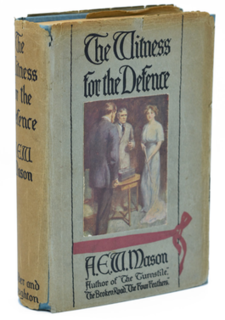
The Witness for the Defence is a 1913 mystery and adventure novel by the English novelist A. E. W. Mason, published by Hodder & Stoughton. Considered one of Mason's best, it was adapted by the author from his 1911 stage play of the same name. In 1919 it was made into an American silent film The Witness for the Defense directed by George Fitzmaurice.

The Turnstile is a 1912 political novel by the English author A. E. W. Mason. The novel's fictional hero was based party upon the author's own experiences as a Member of parliament, and partly upon his friend Robert Falcon Scott, who at that time had yet to start out on his ill-fated expedition to the South Pole.

The Affair at the Semiramis Hotel is a 1917 detective novella by the British writer A. E. W. Mason featuring his character Inspector Hanaud. Mason had originally written many of the plot elements for an abortive silent film, to be called The Carnival Ball. The novella appeared between Mason's first full-length Hanaud novel, At the Villa Rose (1910), and his second, The House of the Arrow (1934).

The Summons is a 1920 novel of adventure and romance by A. E. W. Mason, published by Hodder & Stoughton. Set just before and during the Great War, the novel recounts the adventures of Martin Hillyard, a secret service agent, and his army officer friend Harry Luttrell who aims to restore the battered reputation of his regiment.
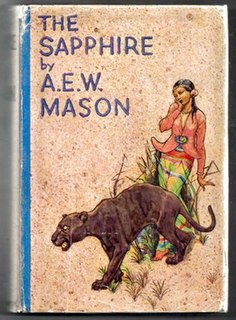
The Sapphire is a 1933 novel of mystery and adventure by A. E. W. Mason, published by Hodder & Stoughton.
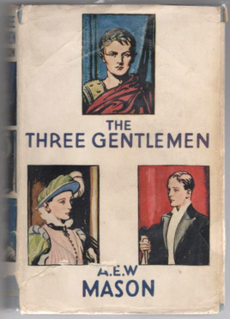
The Three Gentlemen is a 1932 novel of adventure and romance by A. E. W. Mason, published by Hodder & Stoughton. It follows the story of a young couple in ancient Roman times whose love spans the centuries as they are reincarnated in the Elizabethan era, and finally in the early 20th century.

Musk and Amber is a 1942 adventure novel by A. E. W. Mason, set in Eighteenth-century England and Italy. It was his penultimate work, written at the age of 76, and has been considered his very best.
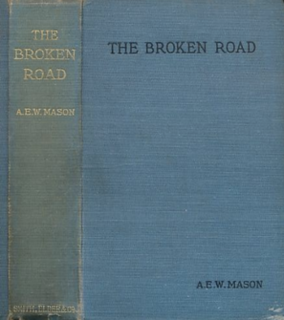
The Broken Road is a 1907 novel of adventure and romance by A. E. W. Mason, set in India during the period of British rule. It first appeared in serial form in The Cornhill Magazine. As a result of the book's publication, the British Government abolished a regulation that had prevented soldiers of the British Indian Army, no matter how valorous, from being eligible to receive the Victoria Cross.
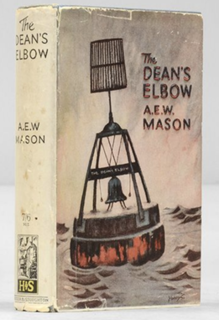
The Dean's Elbow is a 1930 novel by the English novelist A. E. W. Mason, first serialised in Harper's Bazaar from October 1929.


















